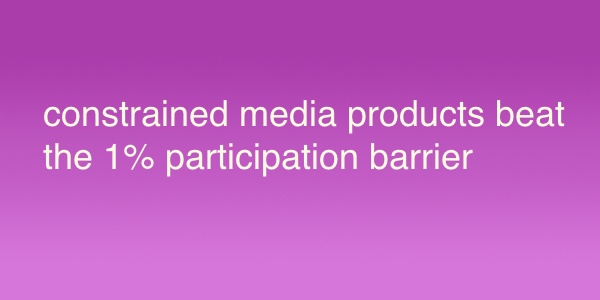Constrained Media. It’s an innovative category of products that ask invite users to create content on a platform, but with arbitrary constraints- Twitter’s 140 character is perhaps the most famous example.
There’s now been a whole series of these apps, quite successful ones, such as:
- write in 140 characters or less (Twitter)
- compose a 6 second video (Vine)
- upload maximum 400×300 thumbnails (Dribbble)
- view a photo in 3 seconds before it disappears (Snapchat)
Why would it make a product more successful by forcing constraints on content creation? Isn’t more always better? Wouldn’t each of these products be better off by removing the constraints? And does every constraint work, or is it all arbitrary?
I’ll argue that the constraints are a fundamental part of what makes the products work. The higher engagement in constrained media products is based on their ability to break through the 1% barrier for content creation. This 1% rule is the famous rule of thumb for user generated content services like Wikipedia or YouTube that says 1% of your users will create content, 9% will edit and curate, and 90% will just sit back and view.
Of course, having only 1% of your users actively creating content sucks. So let’s talk about how to fix that.
Frictionless content creation
The obvious thing is that constrained media apps make it easy to create content. Anyone can type in 140 characters, take a photo, or hit a button to compose 6 second of looping video. Constrast this to a big blank textarea like traditional blogging or a sophisticated photo tool like Photoshop, which requires much more creative energy to use.
More interesting is how these constraints impact the simplicity of the product UI. These constraints mean that the product can support a smaller number of use cases, making it more toy-like, and easy to use. Often, you can power the entire interaction with one button, like Snapchat or Vine. Just hit a button to create content, and once you hit the limit, it’s all over- no worries about editing and rearranging the content.
Both the simplicity of the content, as well as the product UI, makes the whole experience much more directed and higher conversion.
Communication rather than publishing
Building on easy content creation, the next step is shift the context to communication, rather than publishing, which encourages a higher level of participation. The 1% rule sounds good on paper, but think about it in the context of communication products. What’s the content creation % for email, IM, Skype, or texting? I’m sure it’s a lot higher than 1%, perhaps even close to 100%. The point of communication is that all parties involved create content that’s directed at other people, and everyone participates.
Twitter has @mentions, Dribbble has rebounds, and Snapchat is all about communication. This invites people to participate, because the media can be directed at other people, and there’s a built-in context to talk to one another. This leads to email notifications based on healthy user-to-user engagement. This drives frequency, virality, and all sorts of other good stuff.
Replying is easier than creating
Creating content from scratch is hard. Similarly, being the first to communicate can be hard- anyone who’s introduced themselves to a stranger knows the feeling. However, replying is easy. If someone takes a picture of themselves making a funny face on Snapchat, then a natural response is to make a funny face back. Even more if you know that the picture was sent specifically to you, then you feel like you owe a response.
If anything, this increases the constraints- you have the constraint of knowing who you should reply to, and also the constraint of the kind of content that was sent to you. And surprisingly, these constraints make it easier to come up with something to send back.
Make casual content OK by reducing the variance in effort
Nobody likes a showoff. And in fact, a platform with too many showoffs lead to funny social norms, where people tend not to participate because they don’t want to compete with those who are more skilled or who have more time.
Instead, constrained content creation reduces the variance in output between the low-skilled and high-skilled users, which makes it so that everyone can have fun. The best analogy for this might be something like kickball versus professional baseball, where the former is more about everyone having participate by “dumbing down” the sport, not winning. Dribbble is a community of designers where posting your in-progress work in 400×300 “shots” is part of the norm- meaning more frequency and engagement. Constrast this to portfolio sites that you update once a year at most.
Discoverability of content is an important factor too. If you make it too easy to find the more effortful or highest skill content, this creates a kind of leaderboard that discourages content creation, although the content consumption experience might be improved. It’s a tradeoff. Snapchat’s private, ephemeral context means that it’s the only place where it’s safe to post crappy selfies of yourself.
What do you do with all that extra engagement?
All of the above translates to more frequent, more inclusive content creation. This powers traction. More frequency of use means there’s more opportunities to take users through viral loops, as well as firing organic user-to-user notifications that power retention. It becomes easy, for instance in Snapchat’s case, to ask the user to include a couple extra recipients of a photo after you’ve replied. Or after you’ve created a 6 second video, it’s easy to ask the user to share it onto a couple different social networks.
So the next time you’re designing a new social product, consider adding a constraint, but not any arbitrary one. Make it one that makes content creation easy, more communication-oriented, and produces the social norms you want. That’s the best way to beat the 1%.
